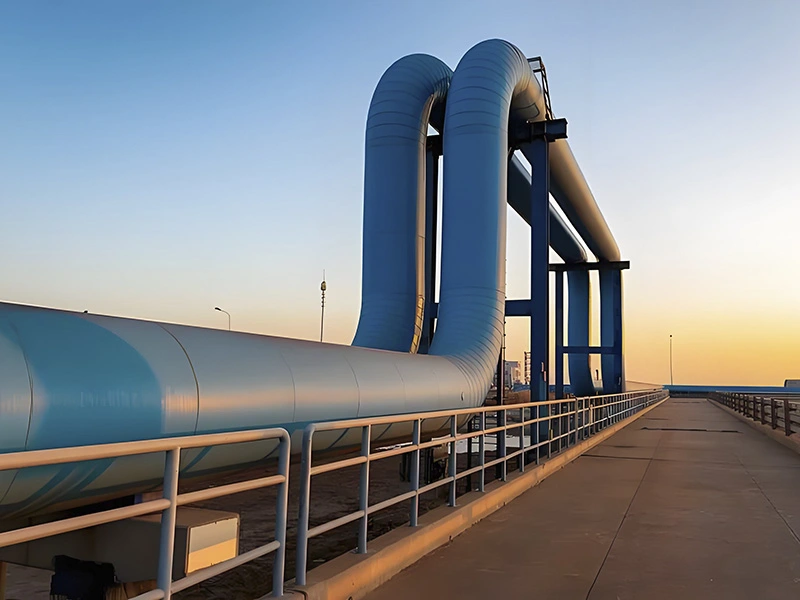In oil and gas engineering, the main types of pipelines include:
- Gathering Lines: Transport crude oil or natural gas from wells to processing facilities.
- Transmission Pipelines: Move processed oil or gas over long distances to refineries or distribution centers.
- Distribution Pipelines: Deliver natural gas to end-users, such as homes and businesses.
- Flow Lines: Connect individual wells to gathering lines or processing units.

Seamless steel pipes are widely used in oil and gas engineering due to their high strength, durability, and corrosion resistance. They are commonly employed in drilling, transportation, and distribution of oil and natural gas. These pipes are ideal for high-pressure environments, ensuring safe and efficient operation.
Carbon Steel Seamless Pipe Grades
Pipes made of carbon steel come in various grades, each tailored for the specific application it is intended to serve—be that application determined by temperature, pressure, or the material being conveyed through the pipe.Commenly as follow:
- ASTM A106 – This grade is extensively applied for high-temperature jobs. It suits seamless pressure pipe applications and is something you’re likely to encounter in refineries, power plants, and boilers. A106 pipes can withstand extreme heat and pressure, making them suitable for use in superheated steam services or for transferring high-temperature fluids.
- ASTM A53 – Pipes made from A53 specifications are appropriate for low to medium pressure and are used in structural applications or water, steam, and air systems. They come in both welded and seamless forms and are versatile across commercial and industrial projects.
- API 5L – Created by the American Petroleum Institute, this grade is meant for carrying oil, gas, and water through pipelines. API 5L pipes provide first-rate strength and resistance to corrosion, especially in sour service settings. It’s an oil and gas industry benchmark.
- ASTM A333 – This grade is intended for low-temperature work, usually in the application of cryogenics or cold-weather processes. The A333 pipe is stress-relieved and has good impact resistance at sub-zero temps, making it a prime choice for the colder parts of the world.
Comparison Table of Carbon Steel Grades
| Grade | Application | Temp Range | Key Features |
| A106 | Boilers, refineries | Up to 750°F | High temp & pressure resistance |
| A53 | Water, steam, air lines | Up to 550°F | Versatile, economical |
| API 5L | Oil & gas pipelines | Varies | Seamless flow, corrosion resistance |
| A333 | Low-temp service | -50°F to +650°F | Toughness in sub-zero conditions |
Specifications of Carbon Steel Seamless Pipes
Carbon steel Seamless pipes are offered in various standards, sizes, and lengths. The majority fall under the specific ASTM, API, and ASME sets of standards. They can be produced to a number of different specifications, with some of the more common ones being for either hot-rolled or cold-drawn pipe, and are generally supplied with either smooth, plain, or grooved ends. Bevels on the ends are optional but fairly common.
| Specification | Description |
| Standard Sizes and Dimensions | Available in a wide range of diameters and wall thicknesses, following nominal pipe sizes (NPS) and schedules (e.g., Schedule 40, Schedule 80). |
| Wall Thickness | Varies depending on application; thicker walls provide higher pressure ratings and strength. |
| Material Grades | Common grades include: ASTM A106: High-temperature and high-pressure applications. ASTM A53: Low to medium pressure applications (water, steam, air). API 5L: Oil and gas pipelines with corrosion resistance. ASTM A333: Low-temperature service, cryogenics. |
| Manufacturing Process | Made without seams by piercing a solid billet and elongating it into a hollow tube through hot rolling or cold drawing. |
| End Finishes | Can have plain ends, beveled ends, or threaded ends to facilitate pipe joining. |
| Surface Finish | Includes smooth or coated finishes such as: – Galvanization: Zinc coating for corrosion resistance. – Epoxy Coatings: Protection against corrosion in harsh environments. – Paint Linings: Added durability and corrosion protection. |
| Pressure and Temperature Ratings | Varies by grade and wall thickness, with specific ratings for high-temperature and high-pressure applications. |
| Compliance with Standards | Manufactured to meet ASTM, API, and ISO standards for safety, quality, and performance. |
| Tensile Strength and Yield Strength | Tested for tensile strength and yield strength to determine force limits before deformation or failure. |
Applications of Carbon Steel Seamless Pipes
Oil and Gas Sector – The oil and gas sector employs carbon steel seamless pipes on a grand scale, covering upstream (drilling), midstream (transport pipeline), and downstream (refinery) operations. When it comes to transporting crude oil, natural gas, and petroleum derivatives over long distances, these pipes have strength to spare and then some; they’re really, really good at not bursting and making other stuff ‘go boom’ under high internal pressure.
Petrochemical and Refinery – In chemical plants and refineries, the pipes encounter corrosive fluids, high-pressure steam, and volatile chemicals. Their durability and heat resistance make them a reliable choice for complex refinery systems and reactor piping.
Power Plants and Boilers – Superheaters, boilers, heat exchangers, and feedwater systems rely on high-performance carbon steel pipes. These pipes endure the extreme heat and pressure that assure nearly continuous power generation.
Automotive and Construction – Seamless pipes are used in the automotive and construction sectors to manufacture chassis, suspension parts, and components for hydraulic systems. They are also used for structural frameworks and scaffolding. Seamless pipes are highly resistant to tensile and impact forces, and that makes them a dependable material for mechanical and structural applications.

Frequently Asked Questions
Q: What is carbon steel?
A: Carbon steel is a type of steel that primarily consists of iron and carbon. It is known for its high strength and durability, making it suitable for various industrial applications, including the oil and gas industry.
Q: Why are carbon steel seamless pipes preferred in the oil and gas industry?
A: Carbon steel seamless pipes are preferred in the oil and gas industry due to their exceptional strength, durability, and resistance to corrosion. The seamless manufacturing process eliminates the need for welding, which reduces the vulnerability to corrosion and ensures the integrity of the pipelines.
Q: What are the advantages of carbon steel seamless pipes in the oil and gas industry?
A: Carbon steel seamless pipes offer several advantages in the oil and gas industry,
Ready to find the perfect carbon steel seamless tube for your project? Contact JSFITTINGS today for a competitive quote.
Email: info@jssteelpipes.com
WhatsApp: +8618003119682


